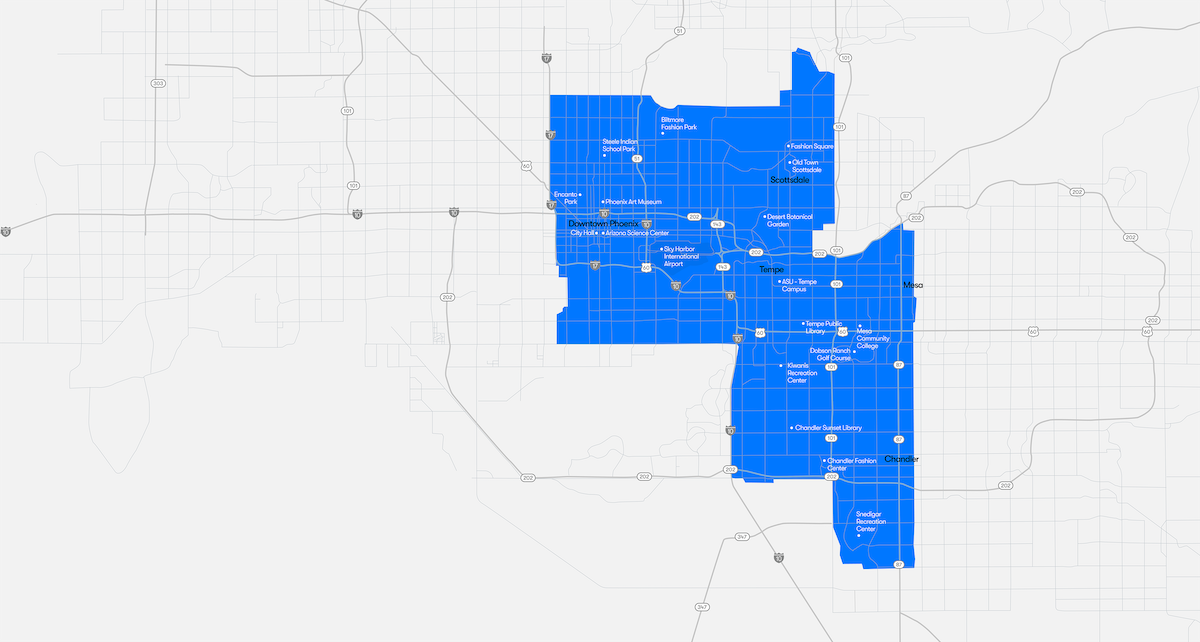
What an incredible year it has been for autonomous driving technology.
So much so that I’m sure that several subscribers have either seen or enjoyed a ride with no one steering the car.
The first time I sat in a self-driving car was in 2011 on the NASA Ames campus in Mountain View, CA. It was one of the earliest prototypes developed by Google. It eventually became Waymo, Alphabet’s (Google’s) self-driving ride hailing division.
Given the sheer financial resources of a company like Alphabet, Waymo has always been a company to watch in this space.
It has seemingly endless computational power available in its Google Cloud division for artificial intelligence (AI) training, combined with one of the largest teams of computer scientists in the world focused on AI. That’s what makes self-driving technology possible.
I was excited to see the latest developments out of Waymo this month.
Just this week, the company reviewed the progress that had been made this year (2023).
Of note, more than 700,000 fully autonomous trips were taken in Waymo vehicles this year. That amounts to more than 126,800 hours of driving entirely performed by artificial intelligence.
I suspect, for most of us, that’s a heck of a lot more than we might have guessed.
Waymo has been operating daily in two cities this year — Phoenix and San Francisco. In fact, it conducts more than 10,000 rides every week in both cities. For perspective, that compares to around 150,000 rides provided by Uber and Lyft daily in San Francisco.
I’ve experienced it myself. In the summer of 2021, in the middle of plandemic, I flew out to Phoenix to experience Waymo’s technology the moment it came out of a limited access beta trial. It was fantastic back then, and it is far better now.
The reason is simple: Waymo has had two-and-a-half years to collect real-time data from all of those rides and conduct massive simulations and training of its AI on a daily basis.
Aside from the data for passenger rides, Waymo runs 24/7 simulations on about 25,000 virtual vehicles on Google Cloud’s computing infrastructure.
One of the obvious benefits of continuous improvement of its self-driving AI is the ability to expand its service offering.
One of the bigger developments at Waymo this year has been to double the size of its service area in metropolitan Phoenix. That’s a major improvement.

Waymo added Scottsdale and connected its downtown Phoenix and East Valley areas into one contiguous block of about 180 square miles.
This highlights a striking difference between Waymo’s technology and that of its primary autonomous driving tech competitor: Tesla.
Waymo’s service areas are always geofenced — they are defined down to specific streets. The self-driving cars can’t operate outside of those areas. This is due to Waymo’s approach to building its AI.
Waymo collects a very detailed mapping of any service area by driving cars around with radar and LIDAR technology that map out streets at extremely high levels of resolution. All of that data is input into the training of the self-driving AI.
Tesla, on the other hand, designs its self-driving AI to drive anywhere. It learns from maps of any country or area where Tesla cars are being sold.
And the AI is trained on billions of miles of data and video collected from Tesla vehicles operating in real world environments.
Tesla’s approach to AI is far more humanlike in that it uses video inputs from cameras all over the cars fed into its onboard AI, which then infers the correct actions to take every split second.
Training a self-driving AI, regardless of the approach, is a massive undertaking that takes years of effort and easily hundreds of millions of dollars.
A concern that I think many of us have is whether or not riding in a self-driving car is safe or not.
I can speak for myself and say that I felt far safer in my ride in a Waymo back in 2021 than I do with many Uber/Lyft drivers. There is no aggressive driving behavior, turns are smooth, and the braking is never hard or jerky.
And when I have my Tesla drive me, the experience is even better.
Braking is always smooth. I can program how I prefer the AI to drive me. Lane changes are seamless. There is no risk-taking. And the Tesla AI always quickly identifies any traffic or obstacles on the road that require adjustment. And I can see what the Tesla “sees” in real time on the dashboard screen.
But that’s just my experience. What about on a larger scale?
I was excited — but not surprised — to see some great numbers from Waymo.
Just yesterday, Waymo reported that over 7.14 million fully autonomous miles driven in Phoenix, San Francisco, and Los Angeles.
Meanwhile, Waymo had an 85% reduction in injury causing crash rates compared to human drivers. An 85% reduction!
How is this possible?
Simple. Anywhere between 94-96% of all accidents are caused by human error. When the source of the errors is “removed,” the accident rates plummet.
And in a world where every driver has a smartphone and those phones are used while driving (note: on rare occasion, I’m guilty of that, too), these numbers make perfect sense.
And this isn’t the first time we’ve seen this radical improvement in safety.
Once planes started flying themselves, aviation crashes absolutely plummeted. Fortunately, it’s now pretty rare for a plane to crash. But when it does, 80% of the time it is still due to human error. The same is true of boats.
This is the single, best argument for national regulatory bodies to be supportive of self-driving technology. It has already proven that it is safer and will save lives.
Let’s consider this: There were 42,939 deaths that occurred from automotive accidents in the U.S. in 2021. If we assume 95% of those were avoided, 40,792 lives would have been saved that year.
And on a global basis, about 1.35 million people die each year from unnecessary automotive accidents.
So where does that leave us? After all, at the moment there are only pockets of self-driving services with Waymo in Phoenix, San Francisco, and Los Angeles, with Austin to follow soon. It will take forever right?
That might be what the automotive industry wants us to think.
After all, they were waaaaay behind on electric vehicle technology… and even farther behind on self-driving technology.
And none of it is true.
Self-driving technology is real, available, and capable of driving just about anywhere we’d like to go.
But its only available in one kind of car… a Tesla.
The automotive industry hates and fears Tesla. And the mass media feels the same way, because Tesla spends almost nothing on advertising, which is why the company gets so little media coverage concerning its incredible innovations.
Tesla’s full self-driving (FSD) software is insane. Absolutely incredible.
And with each month that passes, it continues to improve.
There’s no geofencing required like with Waymo. Simply plug in your destination. And go.
How do I know? I bought a Tesla with the full self-driving package so that I can track the progress and development of the self-driving technology.
How many analysts do you know who did this? I’m not kidding. Nothing beats boots-on-the-ground research.
Here’s a short clip of me being driven by my Tesla this morning, no joke:

It was about a 20-minute drive from my house to my destination (for some Christmas shopping).
The car drove through four-way intersections, streetlights, and around delivery trucks parked on the road…
It drove onto a highway, changed lanes appropriately, exited the highway, and navigated to my destination. All I had to do is pay attention and enjoy the ride.
Every few minutes, the car asks me to touch the steering wheel as a way of confirming that I’m alert. But that’s it.
And the only reason the Tesla does that is for regulatory purposes.
That simple safety measure helps to keep the regulators off its back and allow it to continue to test, develop, improve, and ultimately perfect its self-driving technology. Tesla has collected billions of miles of data from its “fleet” of self-driving cars — all of which have been purchased or leased by its customers.
No other player in the self-driving space comes even close to Tesla. No one.
And for anyone that’s skeptical about how good the technology is, here’s a link to a 55-minute video posted two days ago.
A flower store in Torrence, CA needed to drop off flowers at five locations. They used a Tesla with FSD version 11.4.9 to make all five deliveries.
It was all surface roads with a lot of normal and challenging conditions. And it navigated everything with zero takeovers. (Note: a takeover is when the driver has to take control of the wheel).
The reality is that self-driving technology is already here. It’s everywhere.
Millions of self-driving miles are being “driven” each day in Teslas.
But the only people that know about it are those that have one with the Autopilot or Full Self Driving (FSD) package.
Safer, stress-free driving is here to stay. Deaths from automotive accidents will plummet, and that means insurance costs will also decline.
But it won’t be evenly distributed.
Tesla is so far ahead of the industry, I’d argue that there isn’t even a fast follower.
Waymo’s technological approach doesn’t scale quickly. And after that, it is a steep drop-off.
And one of the only other promising options — Cruise, a subsidiary of General Motors — just suffered a massive set back… perhaps a death blow.
GM announced that it has halted production of the Cruise Origin and pausing all driverless operations.
GM tried to spin it in a good light, but it was pathetic.
After having run over a pedestrian and then dragged the woman captured underneath the vehicle, the company was forced to stop all operations in the three cities it had a presence.
The truth is that GM is losing money on every electric vehicle it sells. And just a few months ago, it was forced to state publicly that it was dramatically reducing its production targets for EVs… in the absence of demand for its EVs and building dealer inventories.
And yet the media — “tech” publications like Wired that receive advertising dollars — publish nonsense articles like How GM Beat Tesla to the First True Mass-Market Electric Car.
I spit out my coffee the morning I read that.
This year, Tesla makes up almost 60% of all electric vehicles sold in the U.S. Said another way, Tesla sells more EVs than all of the other EV makers combined (China excluded).
And the most incredible part: Every Tesla sold is capable of self-driving.
Autonomous driving technology is here now, and it is pushing the outer limits of artificial intelligence.
Welcome to the future.
What do you think of this issue of Outer Limits? As always, we welcome your feedback and questions, and look forward to them. We read each and every email. Please write to us by clicking here.